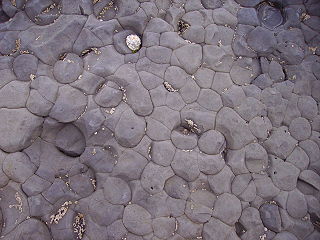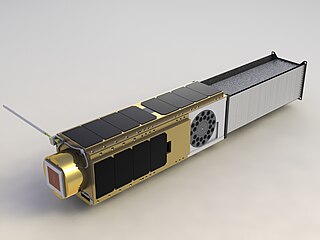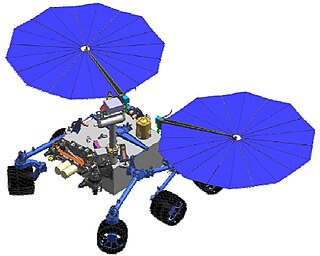
Astrobiology is a scientific field within the life and environmental sciences that studies the origins, early evolution, distribution, and future of life in the universe by investigating its deterministic conditions and contingent events. As a discipline, astrobiology is founded on the premise that life may exist beyond Earth.

Mudstone, a type of mudrock, is a fine-grained sedimentary rock whose original constituents were clays or muds. Mudstone is distinguished from shale by its lack of fissility.

The Astrobiology Field Laboratory (AFL) was a proposed NASA rover that would have conducted a search for life on Mars. This proposed mission, which was not funded, would have landed a rover on Mars in 2016 and explore a site for habitat. Examples of such sites are an active or extinct hydrothermal deposit, a dry lake or a specific polar site.

EXPOSE is a multi-user facility mounted outside the International Space Station (ISS) dedicated to astrobiology. EXPOSE was developed by the European Space Agency (ESA) for long-term spaceflights and was designed to allow exposure of chemical and biological samples to outer space while recording data during exposure.

Martian soil is the fine regolith found on the surface of Mars. Its properties can differ significantly from those of terrestrial soil, including its toxicity due to the presence of perchlorates. The term Martian soil typically refers to the finer fraction of regolith. So far, no samples have been returned to Earth, the goal of a Mars sample-return mission, but the soil has been studied remotely with the use of Mars rovers and Mars orbiters.

The O/OREOS is a NASA automated CubeSat nanosatellite laboratory approximately the size of a loaf of bread that contains two separate astrobiology experiments on board. Developed by the Small Spacecraft Division at NASA Ames Research Center, the spacecraft was successfully launched as a secondary payload on STP-S26 led by the Space Test Program of the United States Air Force on a Minotaur IV launch vehicle from Kodiak Island, Alaska on 20 November 2010, at 01:25:00 UTC.

The Mars Astrobiology Explorer-Cacher (MAX-C), also known as Mars 2018 mission was a NASA concept for a Mars rover mission, proposed to be launched in 2018 together with the European ExoMars rover. The MAX-C rover concept was cancelled in April 2011 due to budget cuts.
Interplanetary contamination refers to biological contamination of a planetary body by a space probe or spacecraft, either deliberate or unintentional.
Camera, hand lens, and microscope probe (CHAMP) is a microscope capable of color imaging with a spatial resolution ranging from infinity imaging down to 3 µm per pixel. The instrument was originally developed through the Mars Instrument Development Program (MIDP) in support of robotic field investigations, and was an instrument proposed for use on the 2011 Mars Science Laboratory rover mission to Mars. The instrument would allow examination of Martian surface features and materials on spatial scales ranging from kilometers to micrometers, thus enabling both microscopy and context imaging with high operational flexibility. The instrument would allow for a better understanding of the evolution of the Martian surface over time. More specifically CHAMP would help gather data for a potential habitat for life on Mars.
Rosalind Franklin, previously known as the ExoMars rover, is a planned robotic Mars rover, part of the international ExoMars programme led by the European Space Agency and the Russian Roscosmos State Corporation. The mission was scheduled to launch in July 2020, but was postponed to 2022. The 2022 Russian invasion of Ukraine has caused an indefinite delay of the programme, as the member states of the ESA voted to suspend the joint mission with Russia; in July 2022, ESA terminated its cooperation on the project with Russia. As of May 2022, the launch of the rover is not expected to occur before 2028 due to the need for a new non-Russian landing platform.

Curiosity is a car-sized Mars rover exploring Gale crater and Mount Sharp on Mars as part of NASA's Mars Science Laboratory (MSL) mission. Curiosity was launched from Cape Canaveral (CCAFS) on November 26, 2011, at 15:02:00 UTC and landed on Aeolis Palus inside Gale crater on Mars on August 6, 2012, 05:17:57 UTC. The Bradbury Landing site was less than 2.4 km (1.5 mi) from the center of the rover's touchdown target after a 560 million km (350 million mi) journey.

CheMin, short for Chemistry and Mineralogy, is an instrument located in the interior of the Curiosity rover that is exploring the surface of Gale crater on Mars. David Blake, from NASA Ames Research Center, is the Principal Investigator.

Icebreaker Life is a Mars lander mission concept proposed to NASA's Discovery Program. The mission involves a stationary lander that would be a near copy of the successful 2008 Phoenix and InSight spacecraft, but would carry an astrobiology scientific payload, including a drill to sample ice-cemented ground in the northern plains to conduct a search for biosignatures of current or past life on Mars.

Planetary Instrument for X-Ray Lithochemistry (PIXL) is an X-ray fluorescence spectrometer to determine the fine scale elemental composition of Martian surface materials designed for the Perseverance rover as part of the Mars 2020 mission.

SuperCam is a suite of remote-sensing instruments for the Mars 2020 Perseverance rover mission that performs remote analyses of rocks and soils with a camera, two lasers and four spectrometers to seek organic compounds that could hold biosignatures of past microbial life on Mars, if it ever existed there.

MicrOmega-IR is an infrared hyperspectral microscope that is part of the science payload on board the European Rosalind Franklin rover, tasked to search for biosignatures on Mars. The rover is planned to land on Mars in the mid- or late 2020s. MicrOmega-IR will analyse in situ the powder material derived from crushed samples collected by the rover's core drill.
Raman Laser Spectrometer (RLS) is a miniature Raman spectrometer that is part of the science payload on board the European Space Agency'sRosalind Franklin rover, tasked to search for biosignatures and biomarkers on Mars. The rover is planned to be launched in August–October 2022 and land on Mars in spring 2023.

Bethany List Ehlmann is a professor of Planetary Science at California Institute of Technology and a Research Scientist at the Jet Propulsion Laboratory.

Perseverance, nicknamed Percy, is a car-sized Mars rover designed to explore the Jezero crater on Mars as part of NASA's Mars 2020 mission. It was manufactured by the Jet Propulsion Laboratory and launched on July 30, 2020, at 11:50 UTC. Confirmation that the rover successfully landed on Mars was received on February 18, 2021, at 20:55 UTC. As of 11 July 2023, Perseverance has been active on Mars for 849 sols since its landing. Following the rover's arrival, NASA named the landing site Octavia E. Butler Landing.























